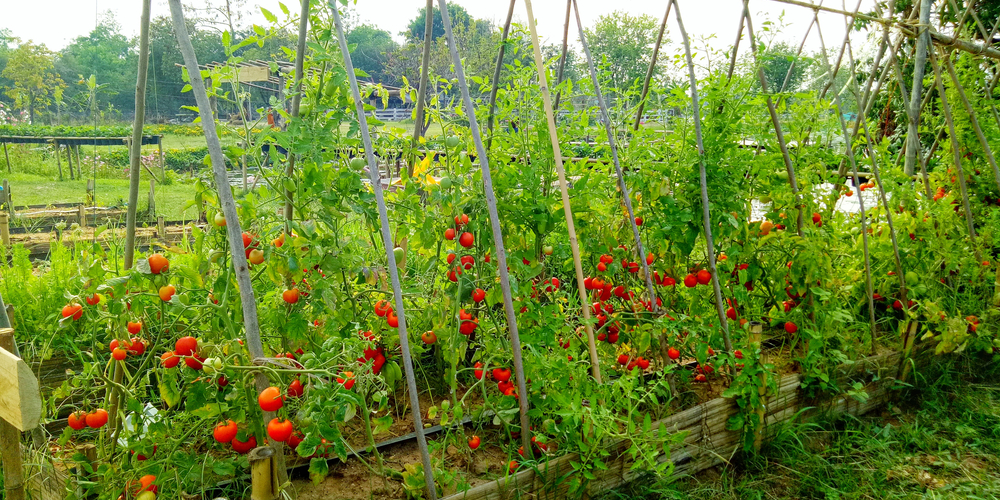Growing a vegetable garden is fun. If you have done that already, you know the feeling. When all of the time spent maintaining your yard gives fruits, the satisfaction is high. But if you have limited space in your yard (and even if you don’t), you might be wondering: “How tall do tomato plants grow?”
And even if growing veggies in your garden isn’t particularly challenging, it takes some while to master the art. For instance, you must learn which plants work well in your region, their water and nutrient needs, and keep an eye on pests and diseases.
One of the most common vegetables to grow in any yard are tomatoes. Under optimal conditions, these plants will give your plenty of harvests. Growing them can be rewarding.
Plus, if you provide them with full sun and all the nutrients they need, their fruits are tasty and easy to grow. And the best part is that you can choose among a variety of tomato plants: Ensure you pick one that suits your local climate and garden’s conditions (and, of course, your taste!).
How Tall Do Tomato Plants Grow?
You’ll need to ensure you can support your plants’ growth. To learn how to prepare your garden to welcome tomatoes, keep reading.
Here, you’ll find everything you should know before planting tomato plants in your garden.
How to Prepare Your Garden For Growing Tomatoes
Under ideal conditions, tomato plants will grow fast. And they can grow into enormous plants if they like your garden, getting to the point of taking over an entire bed.
Tomato height
But the good thing about tomatoes is that, by pruning their plants, you can keep them to a relatively smaller size. Giving you a range of how tall tomatoes plants grow is challenging.
It depends on the variety you are growing and on the level of care your plants receive. Some tomato plants can reach up to 20 feet high (when not pruned), but most will stay at around 8-12 feet.
If you need something smaller, don’t worry: some varieties won’t grow more than 6 inches tall!
Soil
If you can plant them in rich fertile soil and place them in a location that receives plenty of sunshine, you shouldn’t have problems with these plants.
Water
Also, don’t forget to water your tomatoes frequently: they need plenty of moisture to thrive.
Mulch
If you live in a hot and dry place, ensure you add a thick layer of mulch around your plants.
Fertilization
Invest in a slow-releasing balanced fertilizer and feed your plants in the spring to boost their growth (and get more harvests).
Avoid high-nitrogen fertilizers as they might make your plants lush and halt the production of fruits. Also, avoid overdoing it: too many nutrients might burn your plants and result in under absorption.
Support
You might need a support structure (bamboo canes work perfectly) to allow your tomatoes to grow vertically. But what more should you know about growing tomatoes, and how can you ensure you get the best out of them?
Growing Tomatoes: Our Tips
Tomatoes are warm-season crops that need plenty of sunlight to grow. If you can, select a location that receives at least 6 hours of light.
Eight hours will be ideal, but if you live in a hot and dry region, you might have to protect your plants from the excessive heat of the afternoon hours.
Keep in mind that these plants do not tolerate frost (or low temperatures) and perform best in USDA hardiness zones between 6 and 10.
Depending on the variety you grow in your garden, your tomatoes might take 60 to 100 days to harvest. For best results, water your plants early in the morning: it allows your tomatoes to get all the moisture they need to survive a hot day.
Give your plants about two inches of water per square foot each week during the growing season: it will encourage a heavy root system. However, avoid overwatering: it can cause severe damage to your plants.
For instance, soggy soil might attract fungal diseases, cause root rot, and make your plants more susceptible to attacks from pests.
How Tall Do Tomato Plants Grow?: Final thoughts
Don’t forget to prune your plants regularly: eliminate dead branches and unhealthy-looking ones to boost fruit production and allow adequate airflow.
Doing so will keep your plants healthy and minimize the risk of attacks from pests and diseases.
Related Article: How to Get Thick Stems on Tomatoes?

